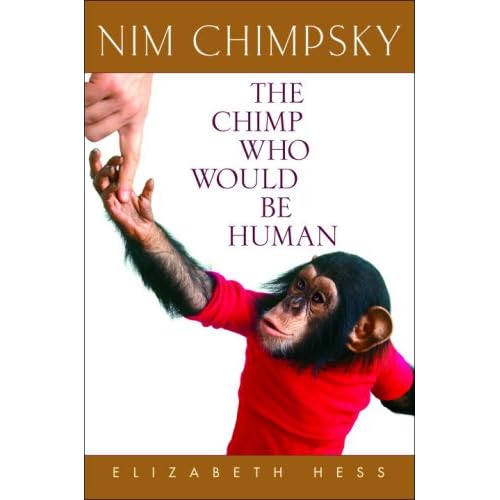
I am not usually one of those writers who delves into the research.
I could say it's 'cuz I want my book to reflect more of what is in my head than what is in the world. Or that I use what I know most intimately as the basis for the characters and events. Or-- as the writer Bret Lott once told me during a Q & A session-- if i'm not verifying the exact location of each traffic light in the exact town and time frame I am referring to, I'm just lazy. Or perhaps it's all of the above. There are many days when lazy would describe my process-- especially when it comes to housework. But I am not looking to recreate that exact town and time and traffic light. What I am getting at, hopefully, is a certain level of empathy and interest, a feel.
But anyway, I did research the likelihood that Sweet Marie, the gibbon, in Family, Genius, Species might exist in the real and larger world. Nim Chimpsky: The Chimp Who Would Be Human by Elizabeth Hess was a big part of this particular vein. I read the entire book while waiting out downed power lines during a winter storm, my three kids wandering around in the dark with their flashlights, messing with the candles, and eating melted ice cream from the carton with serving spoons. To top it off, my flashlight was one of those crank varieties, so every minute or two, I went "RRRrrrrRRRRRrrrrr" from my dark corner, sparking a feeble light. So when I say, "engrossing", you know it damn well had to be.
I tend to prefer novels, but Nim was more intriguing thananything I read that year. It details, not only the complicated story of the famous Nim, but also the recent history of primate language research and the batty world of 70's ideals, touches on the fate of these signing, "humanized" apes-- there were a whole lot of them at one point-- and of Nim himself.
I've always been a big fan of Koko, the signing gorilla. My 3rd grade class once sent a letter to Koko and got a fundraising packet in return, so I have my own dark history where these things are concerned. But this book led me to question the point of this research-- however cool it seems. And yeah, you'd have to be a heartless bastard no to love that kitten story.
But Apes are what they are and coaxing some sort of human interaction from them is not really relevant. In fact, it tells us much more about ourselves, our species-specific vanity than it does about the apes' way in the world, and leads to terrible consequences (primarily for the apes, although the researchers seem to struggle as well).
I should stress here that I am not commenting on Penny Paterson or Koko in particular.
Anyway, one hopes that we've progressed beyond asking a chimp to hang up its coat when it enters "the classroom" and having it sit at a desk and practice. But who knows?
Check this book out!
Also, there's an interview with Hess on Fresh Air.

No comments:
Post a Comment